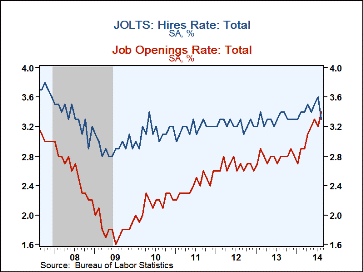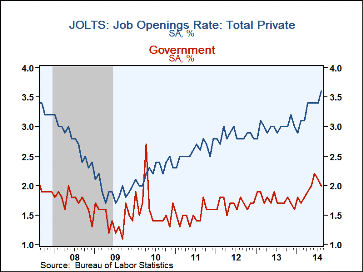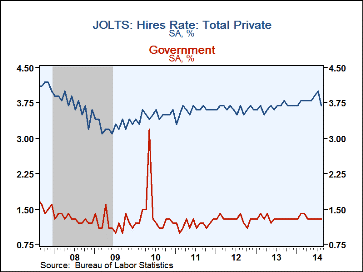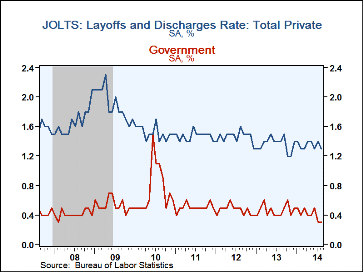 Global| Oct 07 2014
Global| Oct 07 2014U.S. JOLTS: Job Openings Rate Improves Sharply but Hires Rate Deteriorates
by:Tom Moeller
|in:Economy in Brief
Summary
Labor market conditions tightened this summer. The job openings rate during August improved m/m to 3.4%, the highest level since April 2001. July's rate was revised down to 3.2% from 3.3%. The job openings rate is the number of job [...]
Labor market conditions tightened this summer. The job openings rate during August improved m/m to 3.4%, the highest level since April 2001. July's rate was revised down to 3.2% from 3.3%. The job openings rate is the number of job openings on the last business day of the month as a percent of total employment plus job openings. The actual number of job openings surged 23.2% y/y to 4.835 million. The Bureau of Labor Statistics reports these figures in its Job Openings & Labor Turnover Survey (JOLTS).
The private-sector job openings rate improved to 3.6% from a downwardly revised 3.4%. It was the highest level since April 2001 and up from the recession low of 1.7%. The rate in the health care & social assistance sector jumped to 4.3% from 2.0% in January of last year. The leisure & hospitality rate recovered to 4.6% while the professional & business services rate held steady at 4.4%. Also recovered was the 3.1% rate in trade, transportation & utilities industries. The 2.4% rate in the factory sector has been stable for four months. The construction rate fell to 1.9%, the lowest level since April. The job openings rate in the government sector slipped to 2.0% but remained up from 1.3% to 1.7% averaged back to 2008.
Moving in the other direction was the hires rate. It dropped sharply to 3.3% from 3.6% and was at the lowest level since January. The hires rate is the number of hires during the month divided by employment. The private sector hires rate dropped to 3.7%, the lowest since January. Declines spread across industries. The rate in the retail sector fell to 4.4% from 4.9%. The construction hires rate fell sharply to 4.9% and reversed most of its July rise. The factory sector rate dropped to 1.9%, the lowest level in six months. Amongst leisure & hospitality firms, the hires rate slipped to a still-high 5.7%. In professional & business services, it also edged lower to 5.2%. In education & health services, the hires rate notched down to 2.4%. The government sector hires rate held at 1.3% for the fifth straight month.
The number of hires plummeted 6.0% m/m but remained up 1.0% y/y. Private sector hires gained 1.1% y/y as leisure & hospitality jobs jumped 9.7% y/y and professional & business services hiring gained 1.9% y/y. On the soft side, new retail trade jobs slipped 0.4% y/y and construction sector employment was unchanged y/y. Factory sector hiring fell 7.9% y/y while government sector hiring ticked 0.7% higher.
The job separations rate slipped to 3.2% but the actual number of separations increased 0.5% y/y. Separations include quits, layoffs, discharges, and other separations as well as retirements. The private sector separations rate fell to 3.5%, while the government sector's rate inched up to 1.3%. The layoff & discharge rate fell to a record low of 1.1%. The private sector layoff rate inched down m/m to 1.3% but the government's rate was steady at 0.3%.
The JOLTS survey dates to December 2000 and the figures are available in Haver's USECON database.
| JOLTS (Job Openings & Labor Turnover Survey, SA) | Aug | Jul | Jun | Aug'13 | 2013 | 2012 | 2011 |
|---|---|---|---|---|---|---|---|
| Job Openings, Total | |||||||
| Rate (%) | 3.4 | 3.2 | 3.3 | 2.8 | 2.8 | 2.6 | 2.5 |
| Total (000s) | 4,835 | 4,605 | 4,675 | 3,925 | 3,914 | 3,646 | 3,538 |
| Hires, Total | |||||||
| Rate (%) | 3.3 | 3.6 | 3.5 | 3.4 | 39.6 | 38.8 | 38.1 |
| Total (000s) | 4,640 | 4,934 | 4,791 | 4,592 | 54,139 | 52,391 | 50,264 |
| Layoffs & Discharges, Total | |||||||
| Rate (%) | 1.1 | 1.2 | 1.2 | 1.2 | 14.6 | 15.5 | 15.7 |
| Total (000s) | 1,580 | 1,726 | 1,657 | 1,701 | 20,006 | 20,979 | 20,735 |
Tom Moeller
AuthorMore in Author Profile »Prior to joining Haver Analytics in 2000, Mr. Moeller worked as the Economist at Chancellor Capital Management from 1985 to 1999. There, he developed comprehensive economic forecasts and interpreted economic data for equity and fixed income portfolio managers. Also at Chancellor, Mr. Moeller worked as an equity analyst and was responsible for researching and rating companies in the economically sensitive automobile and housing industries for investment in Chancellor’s equity portfolio. Prior to joining Chancellor, Mr. Moeller was an Economist at Citibank from 1979 to 1984. He also analyzed pricing behavior in the metals industry for the Council on Wage and Price Stability in Washington, D.C. In 1999, Mr. Moeller received the award for most accurate forecast from the Forecasters' Club of New York. From 1990 to 1992 he was President of the New York Association for Business Economists. Mr. Moeller earned an M.B.A. in Finance from Fordham University, where he graduated in 1987. He holds a Bachelor of Arts in Economics from George Washington University.










